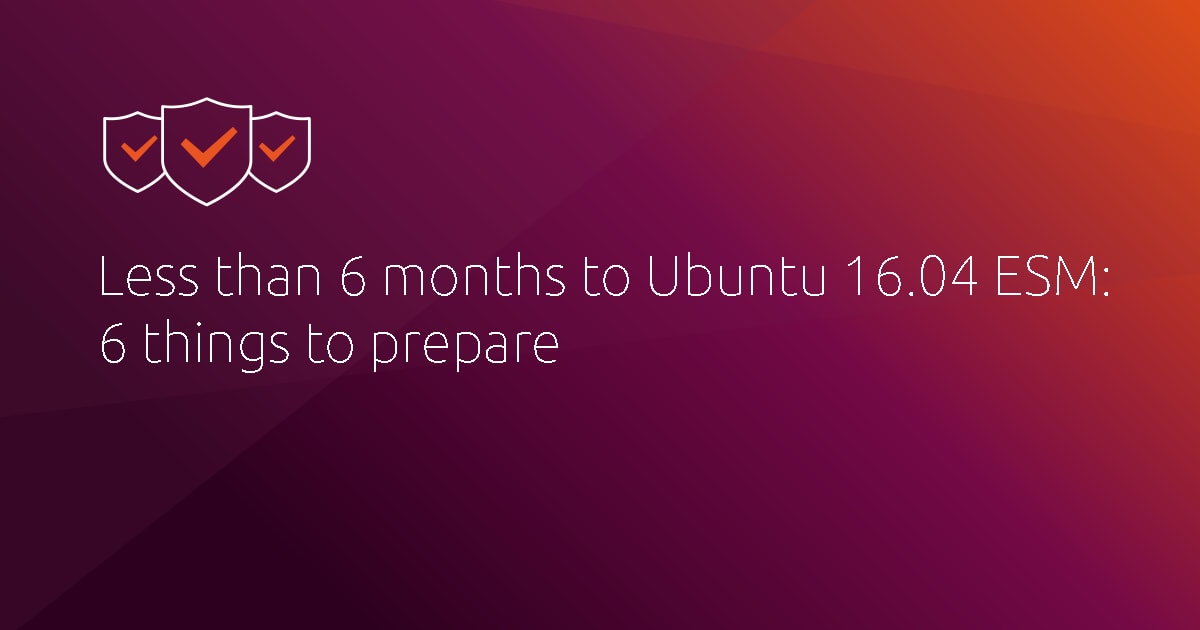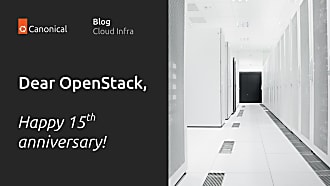Lech Sandecki
on 11 November 2020
Less than 6 months to Ubuntu 16.04 ESM: 6 things to prepare

Ubuntu 16.04 LTS Xenial Xerus will enter the extended security maintenance (ESM) period in April 2021. This article explains the ESM period and provides a guide for six key considerations when planning a migration path from Ubuntu 16.04 LTS.
Contact us with your ESM questions
What is ESM?
Every Ubuntu Long Term Support (LTS) release has two maintenance periods – the standard security period and the extended security maintenance (ESM) period. After the standard five-year security maintenance and updates period, Ubuntu LTS can benefit from an extended period of maintenance and security patching. With ESM, Ubuntu 16.04 gains three extra years of security updates, shifting its end of life date to April 2024.
What should I do?
Here are six key considerations:
1) Think about what it would take to migrate from 16.04 LTS. You can either upgrade your 16.04 LTS to 18.04 LTS, or get yourself a fresh install of the latest Ubuntu 20.04 LTS. If you want to upgrade from 16.04 LTS to 20.04 LTS there is no direct way, so you would need to follow two upgrade procedures: first to 18.04 LTS and finally to 20.04 LTS.
Watch the 20.04 migration webinar
2) Consider the full stack. The OS is a heart of the system, and an OS migration is a significant change that touches multiple aspects of your configuration, from the Linux kernel up to your applications. Remember to evaluate how the migration will impact your existing workloads and APIs as your current configuration might depend on specific versions of the applications and libraries that shipped with Ubuntu 16.04 LTS. You will likely find newer versions of applications and libraries if you choose a more recent version of Ubuntu (you can find a few examples below). Those versions might not be fully compatible with your overall configuration anymore after the migration.
Application | 16.04 LTS version | 18.04 LTS version | 20.04 LTS version |
|---|---|---|---|
MySQL | 5.7 | 5.7 | 8.0 |
PostgreSQL | 9.5 | 10 | 12 |
nodejs | 4.2.6 | 8.10 | 10.19 |
PHP | 7.0 | 7.2 | 7.4 |
Python | 2.7.12 | 2.7.15 | 3 |
Ruby | 2.3 | 2.5 | 2.7 |
3) Evaluate the risks. Each migration project needs to be carefully planned and executed. Make sure that you understand the full stack: the infrastructure and also the applications running on top. Ensure that all your stakeholders who are using services provided by Ubuntu 16.04 workloads also understand the benefits and risks coming from the migration project.
Different categories of risks to take into account: costs and delay of the code migration for the existing apps, cost of maintaining ageing infrastructure and codebase, the overhead of running a migration project, compliance and security risks of running unpatched infrastructure, etc.
4) Take a step back to assess your options. Having a good overview of your Ubuntu 16.04 LTS estate will help you identify workloads that should continue running on 16.04 and those that can benefit from migrations. You can use this occasion to re-think your overall configuration, identify architectural improvements and quantify potential savings. Consider modernising your Ubuntu estate, moving to a cloud-native environment, or evaluate managed services alternatives to your infrastructure and applications. To make the right choice, examine your utilisation levels and total cost of ownership (TCO).
Get started with Charmed Kubernetes ›
Learn more about Canonical OpenStack ›
5) “Intelligent business decision” is a boss. Migrations are costly. Many industries optimise the cost of their workloads for long-term deployments, in which case the longer it operates without downtime and code maintenance, the better price-performance it achieves. ESM extends the lifetime of Ubuntu 16.04 LTS until 2024. Oftentimes, postponing a costly migration for three years can save you hundreds of thousands of dollars, and reduce the risk related to the project. ESM does it all while keeping your workloads compliant and secure.
Learn more in this ESM case study
6) Consider Ubuntu Pro for your cloud instances. If you’re unsure of which path to take, need flexibility in your timeline or just a bit of an extra time buffer for your migration project, consider using Ubuntu Pro on a public cloud. Ubuntu Pro is a premium image from Canonical dedicated to production workloads. It includes ESM and is billed by the hour. Moving to Pro you can enjoy Ubuntu 16.04 until 2024, or earlier if you want, with no contract or commitment.
Get started with Ubuntu Pro for AWS ›
Get started with Ubuntu Pro for Azure ›
Get started with Ubuntu Pro for GCP ›
How can I get help?
Canonical is the publisher of Ubuntu providing extended security and hardening, certified compliance, up to 24×7 support and fully managed services for the whole stack of open infrastructure and applications.
Arrange a 30 minute consultation session



